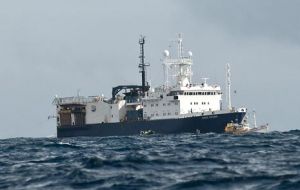MercoPress. South Atlantic News Agency
NZ environmentalists accuse Petrobras oil exploration of penguins’ deaths
 The ‘Orient Explorer’ had to cease all activities
The ‘Orient Explorer’ had to cease all activities Environmentalists in New Zealand asked the government to halt an offshore oil exploration project being conducted for Brazilian oil giant Petrobras in the wake of the deaths of dozens of penguins, the press reported.
The claimants, who include a Maori group, are demanding an investigation to determine whether the sea birds died due to the ultrasound and seismic scans being used in the Petrobras exploration project.
New Zealand’s Environment and Conservation Organizations, ECO, group cited a recent study that found that squid, octopuses and cuttlefish died from ultrasound exploration for oil and gas in Spain between 2001 and 2003.
“The scientists found that the organs that allow squid, octopuses and cuttlefish to balance themselves and carry out their movements were damaged, preventing them from feeding or moving, and they were left at the mercy of predators,” ECO co-chairman Barry Weeber said.
Environmentalists have been following the ships conducting the exploration work for Petrobras off New Zealand’s North Island since the beginning of this month.
Environmental groups fear that offshore oil production will lead to spills like the one that affected the Gulf of Mexico after BP’s Deepwater Horizon drilling rig exploded on April 20, 2010, while working in the Macondo field.
Petrobras temporarily suspended a survey of offshore areas in New Zealand on April 10 after several environmental activists jumped into the water to block the passage of the ship conducting the study. Petrobras ordered Orient Explorer to halt all activities.
The Brazilian corporation began exploring this month for oil and gas in a 12,000 sq. kilometres area in the Raukumara Basin off East Cape. Last year the corporation was awarded oil and gas off-shore exploration licences.




Top Comments
Disclaimer & comment rules-

-

Read all commentsoil exploration in the sea and its consecuences www.diariopanorama.com/seccion/firmas_22/catastrofe-ecologica-en-malvinas-a-causa-de-la-explotacion-petrolera_a_89345
Apr 28th, 2011 - 12:09 pm 0The Petrobras seismic surveys are, almost certainly, one or two air-gun arrays towed about 200 m behind the survey vessel, with cables, called streamers, containing a few thousand hydrophone sensors
Apr 28th, 2011 - 09:23 pm 0Air-gun arrays typically involve 12-48 individual guns and an air-gun releases a volume of air under high pressure, creating a sound pressure wave.
The acoustic pressure output of an air-gun array is directly proportional to its operating pressure, 2,000psi, and the peak pressure levels emitted from commonly used seismic industry air-gun arrays are in the 5-300 Hz range.
Vertical output is maximized - while minimizing output in the
horizontal plane - through the use of focused arrays incorporating more small airguns rather than one or a few larger air-guns.
The maximum pressure level an animal could experience from an air-gun source in use today in the seismic industry will be 240 dB, vertically under the vessel array. Sound/pressure levels are minimal horizontally away from the array – ie, away from the vessel where penguins might be.
During a survey run, the array is towed at 5 knots and is fired every 10 seconds. A typical seismic operation involves a series of parallel passes by a vessel towing one or two air-gun arrays.
Thus, a seismic crew can get into and out of a specific area much more quickly than in times past because fewer tracks are required, given the wider coverage (swath) of the attenuated return signal per track.
When an oil field is up and running they sometimes use seismic time-lapse monitoring (4D) for reservoir management (repeating seismic surveys to monitor changes in a hydrocarbon reservoir and draw-down over the months and years of its productive life). This means that is more seismic activity over *producing* fields than was true in the past.
Commenting for this story is now closed.
If you have a Facebook account, become a fan and comment on our Facebook Page!